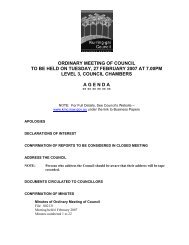Pymble Business Park - Ku-ring-gai Council
Pymble Business Park - Ku-ring-gai Council
Pymble Business Park - Ku-ring-gai Council
You also want an ePaper? Increase the reach of your titles
YUMPU automatically turns print PDFs into web optimized ePapers that Google loves.
2.1 DEFINITIONS (CONTINUED)<br />
2<br />
furnishing<br />
green building<br />
green star rating<br />
green waste<br />
greywater<br />
gross pollutant<br />
gross pollutant trap<br />
(GPT)<br />
hazardous waste<br />
holding berm<br />
hopper<br />
hydraulics<br />
hydrology<br />
illuminated sign<br />
impervious<br />
the furniture, appliances, and other movable articles in an outdoor dining<br />
area, but excludes planter boxes, utensils, dining sets and the like.<br />
is one that incorporates design, construction and operational practices<br />
that signifi cantly reduce or eliminate the negative impact of development<br />
on the environment and building occupants.<br />
is an internationally-recognised assessment of the sustainable attributes<br />
of a development which enable it to minimise its impact upon the<br />
environment. The Green Building <strong>Council</strong> of Australia (GBCA) provides<br />
a formal certifi cation process for ratings of Four Star Green Star (‘Best<br />
Practice’) and above; this service provides for an independent third<br />
party review of buildings and their sustainable attributes and initiatives.<br />
organic garden waste. This includes any waste material that in its<br />
raw form comprises vegetation (such as grass, leaves, mulch, plants,<br />
branches, twigs and tree loppings). Green waste does not refer to wood<br />
wastes such as tree stumps or kitchen vegetable scraps.<br />
household wastewater that has not come into contact with toilet waste.<br />
litter and debris that is transported by urban runoff and that is not less<br />
than 5mm in diameter and/or is retained by a 5mm mesh screen.<br />
a structure that acts as a water pollution control measure by intercepting<br />
and retaining gross pollutants (coarse sediment, trash and debris).<br />
any waste that because of its physical, biological or chemical properties,<br />
is capable of causing a danger to the life or health of any living thing if<br />
it is released into the environment, and/or is, or contains a substance<br />
described in the Protection of the Environment Operations Act 1997<br />
e.g. can include dangerous goods, poisons, liquids and other waste<br />
containing hazardous components. If in doubt contact the NSW<br />
Environment Protection Authority or <strong>Council</strong>.<br />
a small bank for retaining water.<br />
a fi tting into which waste is placed and from which it passes into a chute<br />
or directly into a waste container. It consists of a fi xed frame and hood<br />
unit (the frame) and a hinged or pivoted combined door and receiving<br />
unit.<br />
the study of fl ow of fl uid. In civil enginee<strong>ring</strong>, this concerns mainly fl ow<br />
of water in waterways – in particular, the changes in fl ow parameters<br />
such as water level and velocity.<br />
the study of water as it relates to rainfall and the runoff process – in<br />
particular, catchment behaviour, fl ow rates and volumes.<br />
any sign that is internally illuminated.<br />
land or material that is not readily penetrable by water.<br />
DEFINITIONS<br />
Note: For terms not contained in the above list, reference is to be made to the Dictionary in<br />
the Standard Instrument (Local Environment Plans) Order 2006.<br />
Draft <strong>Ku</strong>-<strong>ring</strong>-<strong>gai</strong> <strong>Pymble</strong> Buiness <strong>Park</strong> Development Control Plan 2012<br />
p 15

















